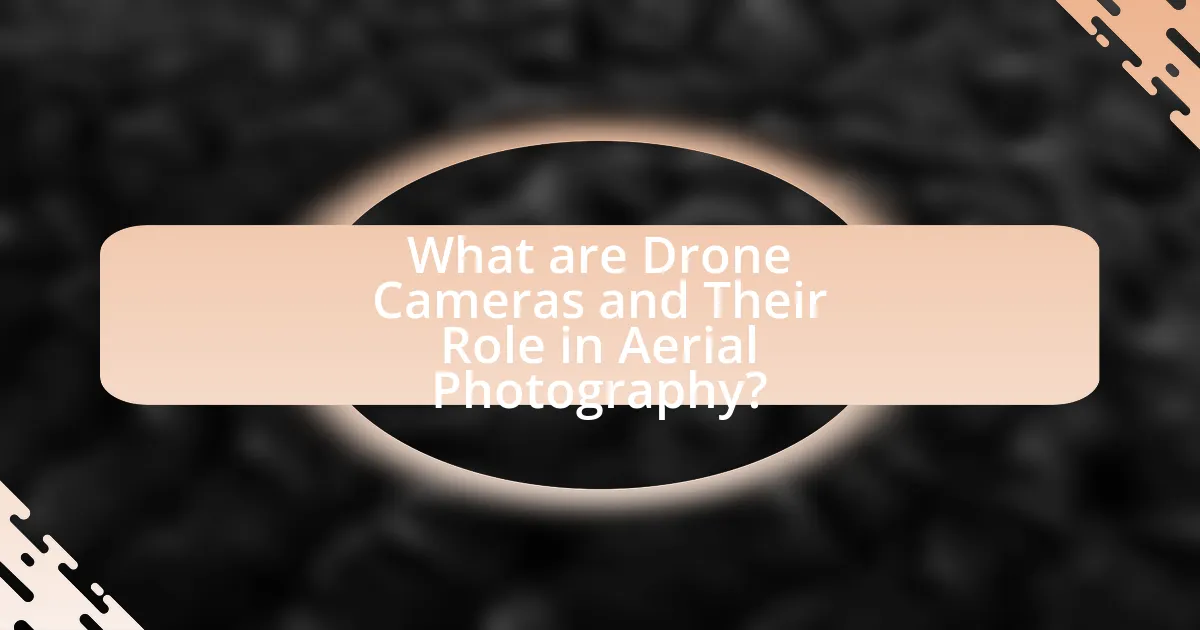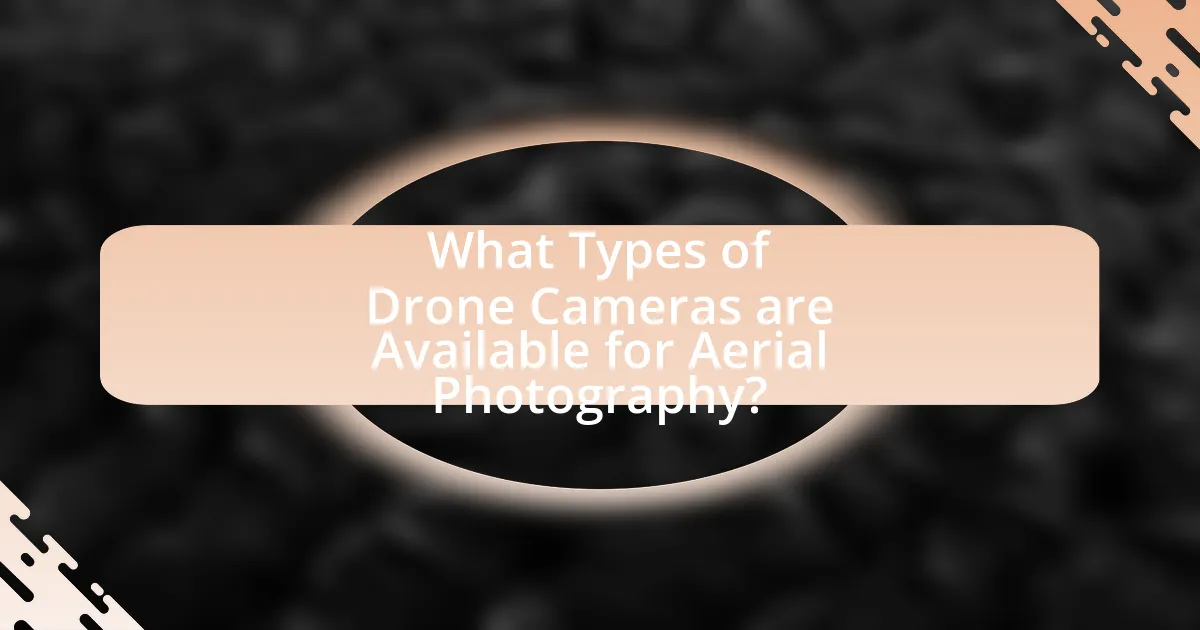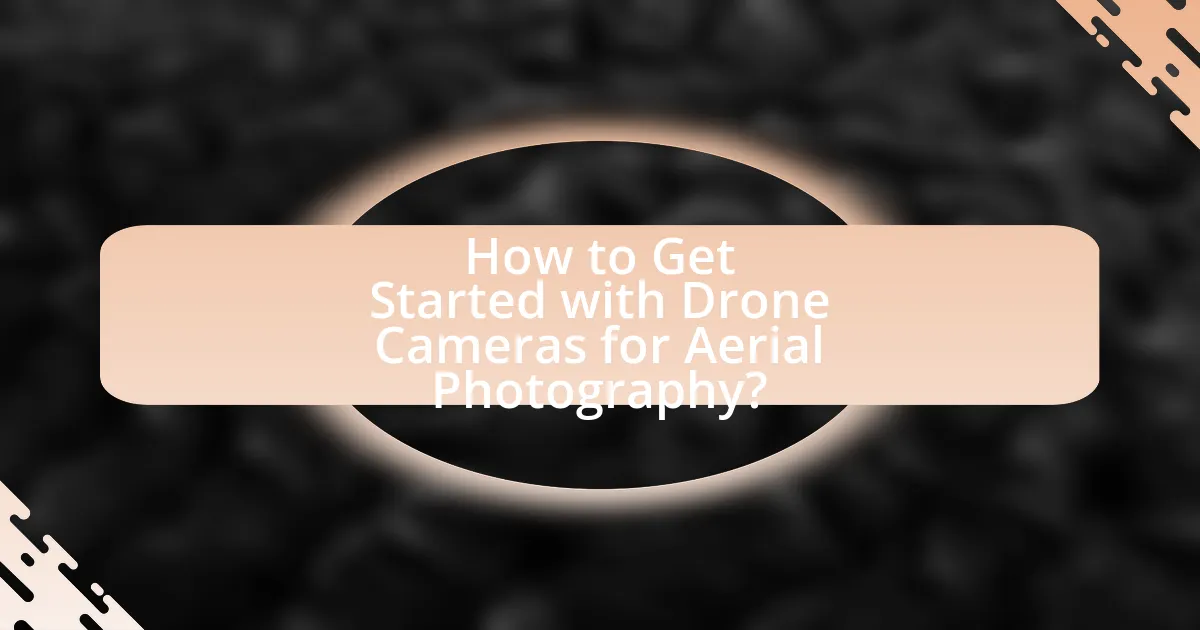Drone cameras, mounted on unmanned aerial vehicles (UAVs), play a crucial role in aerial photography by capturing high-resolution images and videos from unique perspectives. This article explores the differences between drone cameras and traditional cameras, highlighting key features such as stabilization technology, flight modes, and camera quality that enhance aerial imagery. It also discusses the importance of aerial photography across various applications, including urban planning and environmental monitoring, while providing insights into selecting the right drone camera, legal considerations, and techniques to improve aerial photography skills. Additionally, the article addresses common challenges faced by photographers and offers tips for optimizing the aerial photography experience.

What are Drone Cameras and Their Role in Aerial Photography?
Drone cameras are specialized cameras mounted on unmanned aerial vehicles (UAVs) that capture high-resolution images and videos from the sky. Their role in aerial photography is significant, as they provide unique perspectives and access to hard-to-reach locations, enabling photographers and videographers to create stunning visuals that were previously difficult or impossible to achieve. For instance, drone cameras can capture sweeping landscapes, architectural shots, and dynamic action sequences, all while offering stability and precision through advanced stabilization technology. The integration of GPS and automated flight paths further enhances their utility, allowing for consistent and repeatable shots.
How do drone cameras differ from traditional cameras?
Drone cameras differ from traditional cameras primarily in their ability to capture images and videos from aerial perspectives. Traditional cameras are typically stationary or handheld, limiting their vantage points, while drone cameras are mounted on unmanned aerial vehicles, allowing for dynamic movement and access to heights and angles that are otherwise difficult to achieve. This capability enables drone cameras to capture expansive landscapes, unique angles, and complex scenes, which are particularly beneficial in fields like aerial photography, surveying, and cinematography. Additionally, drone cameras often incorporate advanced stabilization technology and GPS features, enhancing image quality and enabling precise control over flight paths, further distinguishing them from conventional camera systems.
What are the key features of drone cameras?
Drone cameras are equipped with several key features that enhance aerial photography. These features include high-resolution imaging capabilities, typically ranging from 12MP to 48MP, allowing for detailed and clear photographs. Additionally, many drone cameras offer 4K video recording, providing high-quality footage for various applications.
Stabilization systems, such as gimbals, are crucial for maintaining steady shots during flight, reducing motion blur. Furthermore, drones often include advanced flight modes, such as follow-me and waypoint navigation, which facilitate automated shooting and creative angles.
Another important feature is the live video feed, which allows operators to see what the camera sees in real-time, aiding in composition and framing. Many drone cameras also support interchangeable lenses, offering versatility for different shooting scenarios.
These features collectively enhance the functionality and usability of drone cameras, making them valuable tools for photographers and videographers.
How does the camera quality impact aerial photography?
Camera quality significantly impacts aerial photography by determining the clarity, detail, and overall visual appeal of the images captured. High-quality cameras equipped with advanced sensors and lenses produce sharper images with better color accuracy and dynamic range, which are crucial for capturing landscapes and intricate details from the air. For instance, cameras with higher megapixel counts can capture more detail, allowing for larger prints and more extensive cropping without loss of quality. Additionally, features such as optical image stabilization reduce blurriness caused by drone movement, enhancing the final output. Studies have shown that aerial photographs taken with superior camera systems yield higher satisfaction rates among photographers and viewers alike, emphasizing the importance of camera quality in achieving professional-grade aerial imagery.
Why is aerial photography important?
Aerial photography is important because it provides unique perspectives and comprehensive views of landscapes, structures, and events that are not possible from ground level. This form of photography is essential for various applications, including urban planning, environmental monitoring, agriculture, and disaster management. For instance, a study by the American Society for Photogrammetry and Remote Sensing highlights that aerial imagery can improve land-use planning by offering detailed insights into geographical changes over time. Additionally, aerial photography enhances data collection for mapping and surveying, making it a critical tool in both commercial and scientific fields.
What applications benefit from aerial photography?
Aerial photography benefits various applications, including agriculture, urban planning, environmental monitoring, and disaster management. In agriculture, aerial imagery allows farmers to assess crop health and optimize resource use, leading to increased yields. Urban planners utilize aerial photography for land use analysis and infrastructure development, enabling better decision-making. Environmental monitoring relies on aerial images to track changes in ecosystems and assess the impact of climate change. Disaster management teams use aerial photography for damage assessment and to plan effective response strategies, enhancing recovery efforts.
How does aerial photography enhance storytelling and marketing?
Aerial photography enhances storytelling and marketing by providing unique perspectives that capture the scale and context of a subject, making narratives more engaging. This visual approach allows brands to showcase their products or services in a way that traditional photography cannot, often evoking emotions and creating a stronger connection with the audience. For instance, a study by the University of California found that images taken from above can increase viewer engagement by up to 60%, demonstrating the effectiveness of aerial visuals in capturing attention and conveying messages.

What Types of Drone Cameras are Available for Aerial Photography?
There are several types of drone cameras available for aerial photography, including compact cameras, mirrorless cameras, and DSLR cameras. Compact cameras are lightweight and often integrated into drones, making them suitable for casual photography. Mirrorless cameras offer higher image quality and interchangeable lenses, appealing to professional photographers. DSLR cameras provide the best image quality and versatility but are typically heavier and require more robust drone models to carry them. Each type serves different needs, from hobbyist to professional applications, ensuring a range of options for aerial photography enthusiasts.
What are the different categories of drone cameras?
The different categories of drone cameras include consumer cameras, professional cameras, thermal cameras, and multispectral cameras. Consumer cameras are designed for hobbyists and typically offer basic features for casual photography and videography. Professional cameras, on the other hand, are equipped with advanced sensors and lenses, suitable for high-quality aerial photography and cinematography. Thermal cameras are specialized for detecting heat signatures, making them useful in search and rescue operations, building inspections, and agricultural monitoring. Multispectral cameras capture data across various wavelengths, which is essential for agricultural analysis and environmental monitoring. Each category serves distinct purposes and is tailored to meet specific user needs in aerial photography and related fields.
How do consumer drones compare to professional drones?
Consumer drones are typically designed for hobbyists and casual users, while professional drones are engineered for commercial applications and advanced functionalities. Consumer drones often feature lower-resolution cameras, limited flight time, and basic stabilization, making them suitable for recreational use. In contrast, professional drones are equipped with high-resolution cameras, longer battery life, and advanced features like obstacle avoidance and enhanced stability, which are essential for tasks such as filmmaking and surveying. For instance, professional drones like the DJI Matrice series can carry payloads of specialized cameras and sensors, enabling high-quality aerial photography and data collection, whereas consumer models like the DJI Mini series focus on ease of use and affordability.
What are the advantages of using specialized drones for specific tasks?
Specialized drones offer significant advantages for specific tasks, including enhanced efficiency, improved data accuracy, and tailored functionalities. For instance, drones designed for agricultural monitoring can utilize multispectral cameras to assess crop health, providing precise data that traditional methods cannot achieve. This specialization allows for targeted interventions, ultimately increasing yield and reducing resource waste. Additionally, drones equipped for search and rescue missions can be fitted with thermal imaging technology, enabling them to locate individuals in challenging environments more effectively than general-purpose drones. These advantages demonstrate that specialized drones optimize performance and outcomes in their designated applications.
What features should you consider when choosing a drone camera?
When choosing a drone camera, consider features such as image quality, camera resolution, stabilization technology, flight time, and ease of use. High image quality is essential for capturing detailed aerial photographs, with a resolution of at least 12 megapixels being standard for good results. Stabilization technology, like gimbals, ensures smooth footage, reducing the impact of vibrations during flight. Flight time typically ranges from 20 to 30 minutes, which affects how much area can be covered in a single session. Additionally, user-friendly controls and features like automated flight modes enhance the overall experience, making it easier for both beginners and experienced users to operate the drone effectively.
How does flight time affect your aerial photography experience?
Flight time significantly impacts your aerial photography experience by determining how long you can capture images from the air. Longer flight times allow for more extensive coverage of a location, enabling photographers to explore various angles and compositions without the need for frequent landings to recharge or swap batteries. For instance, drones like the DJI Mavic 3 offer flight times of up to 46 minutes, which is advantageous for capturing expansive landscapes or complex scenes in a single flight. In contrast, drones with shorter flight times may limit the number of shots you can take, potentially missing critical moments or perspectives. Therefore, the duration of flight directly influences the quality and variety of aerial photographs you can achieve.
What is the significance of camera stabilization in drone photography?
Camera stabilization is crucial in drone photography as it ensures smooth and clear images by minimizing motion blur caused by vibrations and wind. This stabilization allows for high-quality footage and sharp photos, which are essential for professional aerial photography. Studies show that drones equipped with gimbals or electronic stabilization systems can reduce unwanted camera movements by up to 90%, significantly enhancing the visual quality of the captured content.

How to Get Started with Drone Cameras for Aerial Photography?
To get started with drone cameras for aerial photography, first select a suitable drone equipped with a high-quality camera, such as the DJI Mavic Air 2, which offers 48 MP stills and 4K video capabilities. Next, familiarize yourself with local regulations regarding drone usage, as many regions require registration and adherence to specific flight rules. Additionally, practice flying the drone in open areas to develop your piloting skills, ensuring you can control the drone effectively while capturing images. Finally, invest time in learning photography principles, such as composition and lighting, to enhance the quality of your aerial shots.
What are the essential steps to begin aerial photography with drones?
To begin aerial photography with drones, one must follow these essential steps: first, select a suitable drone equipped with a high-quality camera, as the camera’s specifications directly impact image quality. Next, familiarize yourself with local regulations regarding drone usage, including obtaining necessary permits and understanding no-fly zones, which are crucial for legal compliance. After that, practice flying the drone in open areas to develop piloting skills, ensuring control and stability during flight. Finally, learn basic photography principles, such as composition and lighting, to enhance the quality of aerial images. These steps are validated by the increasing popularity of drones in photography, with the global drone market projected to reach $43 billion by 2024, indicating a growing interest and accessibility in aerial photography.
How do you select the right drone camera for your needs?
To select the right drone camera for your needs, first identify your specific requirements such as image quality, flight time, and budget. High-resolution cameras, like those with 4K capabilities, are essential for professional photography, while a longer flight time allows for extended shooting sessions. Additionally, consider features like gimbal stabilization for smooth footage and the ability to change lenses for versatility. Research shows that drones equipped with advanced sensors and stabilization systems, such as the DJI Mavic series, provide superior performance in various conditions, making them suitable for both amateurs and professionals.
What are the legal considerations for flying drones in your area?
The legal considerations for flying drones in your area include compliance with local regulations, obtaining necessary permits, and adhering to safety guidelines. In the United States, the Federal Aviation Administration (FAA) mandates that drone operators must register their drones if they weigh over 0.55 pounds and follow specific operational rules, such as flying below 400 feet and maintaining visual line-of-sight. Additionally, many states and municipalities have their own laws regarding drone use, which may include restrictions on flying over private property or near sensitive areas like schools and airports. Violating these regulations can result in fines or legal action, emphasizing the importance of understanding and following the applicable laws in your area.
What techniques can improve your aerial photography skills?
To improve aerial photography skills, utilize techniques such as mastering composition, understanding lighting, and practicing drone control. Mastering composition involves applying the rule of thirds and leading lines to create visually appealing images. Understanding lighting is crucial; shooting during golden hours—shortly after sunrise or before sunset—enhances colors and shadows, resulting in more dynamic photographs. Practicing drone control ensures stability and precision, allowing for smoother shots and better framing. These techniques are supported by the fact that well-composed images with optimal lighting can significantly increase viewer engagement and satisfaction in aerial photography.
How can you effectively plan your aerial shots?
To effectively plan your aerial shots, start by defining your objectives and the specific scenes you want to capture. This involves scouting locations in advance, considering factors such as lighting, weather conditions, and the time of day to ensure optimal visibility and composition. Additionally, utilizing flight planning apps can help map out flight paths, set altitude limits, and identify no-fly zones, which is crucial for compliance with regulations. Research indicates that pre-visualizing shots and creating a shot list can enhance efficiency during the shoot, allowing for a more organized approach and reducing the likelihood of missing key moments.
What are the best practices for capturing stunning aerial images?
To capture stunning aerial images, utilize a high-quality drone equipped with a stable camera and advanced features. Ensuring optimal lighting conditions, such as shooting during the golden hour, enhances image quality by providing soft, warm light. Additionally, employing techniques like rule of thirds composition and maintaining a steady flight path minimizes motion blur, resulting in clearer images. Using a higher resolution setting on the camera allows for greater detail and flexibility in post-processing. According to a study by the Journal of Aerial Photography, images taken during optimal lighting conditions can increase visual appeal by up to 30%.
What common challenges do photographers face with drone cameras?
Photographers commonly face challenges such as battery life limitations, regulatory restrictions, and technical complexities when using drone cameras. Battery life typically lasts between 20 to 30 minutes, which can restrict shooting time and require careful planning. Regulatory restrictions, including no-fly zones and altitude limits, can hinder access to desired locations, as many countries have specific laws governing drone use. Additionally, technical complexities, such as mastering flight controls and understanding aerial photography techniques, can pose a steep learning curve for photographers new to drones. These challenges necessitate thorough preparation and knowledge to effectively utilize drone cameras for aerial photography.
How can you troubleshoot connectivity issues with your drone?
To troubleshoot connectivity issues with your drone, first ensure that both the drone and the remote controller are fully charged and powered on. Next, check for any physical obstructions or interference from other electronic devices that may disrupt the signal. Additionally, verify that the firmware of both the drone and the controller is up to date, as outdated software can lead to connectivity problems. If issues persist, try resetting the drone and the controller to factory settings, which can resolve configuration errors. According to a study by the Federal Aviation Administration, maintaining a clear line of sight and minimizing interference can significantly enhance connectivity reliability in drone operations.
What are the best ways to handle adverse weather conditions during flights?
The best ways to handle adverse weather conditions during flights include thorough pre-flight weather assessments, utilizing advanced navigation systems, and implementing real-time monitoring of weather changes. Pre-flight weather assessments allow pilots to identify potential hazards such as thunderstorms or high winds, enabling informed decision-making. Advanced navigation systems, including GPS and radar, assist in avoiding dangerous weather patterns during flight. Real-time monitoring of weather conditions ensures that pilots can adapt their flight paths as necessary, enhancing safety. These strategies are supported by data from aviation safety studies, which indicate that proactive weather management significantly reduces the risk of weather-related incidents in aviation.
What tips can enhance your aerial photography experience?
To enhance your aerial photography experience, utilize optimal lighting conditions, particularly during the golden hour, which occurs shortly after sunrise and before sunset. This time provides soft, diffused light that enhances colors and reduces harsh shadows, resulting in more visually appealing images. Additionally, familiarize yourself with your drone’s camera settings, such as ISO, shutter speed, and aperture, to achieve the best exposure and clarity. Research indicates that understanding these settings can significantly improve image quality, as proper exposure is crucial for capturing detailed aerial shots. Lastly, plan your flight path and composition in advance, considering factors like wind conditions and potential obstacles, to ensure a smooth shooting experience and maximize the potential of your aerial photography.